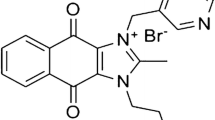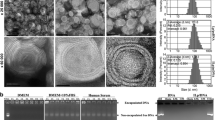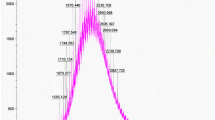ABSTRACT
Purpose
To optimise and simplify preparation of targeted liposomes for efficient siRNA delivery to neuroblastoma, the most common solid tumour in early childhood.
Methods
Liposomes containing siRNA were prepared by combining the novel dual asymmetric centrifugation (DAC) method and the recently optimised sterol-based post-insertion technique (SPIT) to couple anti-GD2 antibody for selective interaction with neuroblastoma cells. Cultured human neuroblastoma cell lines were used to evaluate the efficiency of siRNA delivery.
Results
The size of liposomes prepared by DAC ranged from 190 to 240 nm; siRNA encapsulation efficiency was up to 50%. An average of 70 and 100 molecules of anti-GD2 antibody per particle were coupled. A significant association of liposomes with neuroblastoma cells as well as effective siRNA delivery was observed only when anti-GD2 antibody was coupled. Preliminary data suggest delivery of siRNA using anti-GD2-liposomes occurs via GD2-mediated endocytosis. Vascular endothelial growth factor A (VEGF-A) was down-regulated using siRNA delivered by anti-GD2-liposomes.
Conclusions
DAC and SPIT allow for the straightforward preparation of liposomes for the targeted delivery of siRNA. Anti-GD2-liposomes thus produced can serve as versatile carriers of siRNA to neuroblastoma cells.







Similar content being viewed by others
Abbreviations
- Ab:
-
antibody
- Chol:
-
cholesterol
- cryo-TEM:
-
cryo-transmission electron microscope
- DAC:
-
dual asymmetric centrifugation
- DDAB:
-
dimethyldioctadecylammonium (bromide salt)
- DSPE-PEG2000 :
-
2-distearoyl-sn-glycero-3-phosphoethanolamine-N-[methoxy(polyethyleneglycol)-2000]
- FCS:
-
fetal calf serum
- GD2:
-
disialoganglioside
- HN buffer:
-
HEPES/NaCl buffer
- HSPC:
-
hydrogenated soybean phosphatidylcholine
- L:
-
liposomes
- PBS:
-
phosphate buffered saline
- POPC:
-
1-palmitoyl-2-oleoyl-sn-glycero-3-phosphocholine
- Rhd-PE:
-
rhodamine B 1,2-dihexadecanoyl-sn-glycero-3-phosphoethanolamine triethylammonium salt
- siRNA:
-
short interfering RNA
- SPIT:
-
sterol-based post-insertion technique
- TL:
-
total lipid
- VEGF-A:
-
vascular endothelial growth factor A
REFERENCES
Elbashir SM, Harborth J, Lendeckel W, Yalcin A, Weber K, Tuschl T. Duplexes of 21-nucleotide RNAs mediate RNA interference in cultured mammalian cells. Nature. 2001;411:494–8.
Tiemannand K, Rossi JJ. RNAi-based therapeutics-current status, challenges and prospects. EMBO Mol Med. 2009;1:142–51.
de Fougerolles A, Vornlocher HP, Maraganore J, Lieberman J. Interfering with disease: a progress report on siRNA-based therapeutics. Nat Rev Drug Discov. 2007;6:443–53.
Zimmermann TS, Lee AC, Akinc A, Bramlage B, Bumcrot D, Fedoruk MN, et al. RNAi-mediated gene silencing in non-human primates. Nature. 2006;441:111–4.
Villares GJ, Zigler M, Wang H, Melnikova VO, Wu H, Friedman R, et al. Targeting melanoma growth and metastasis with systemic delivery of liposome-incorporated protease-activated receptor-1 small interfering RNA. Cancer Res. 2008;68:9078–86.
Peer D, Park EJ, Morishita Y, Carman CV, Shimaoka M. Systemic leukocyte-directed siRNA delivery revealing cyclin D1 as an anti-inflammatory target. Science. 2008;319:627–30.
Torchilin VP. Recent advances with liposomes as pharmaceutical carriers. Nat Rev Drug Discov. 2005;4:145–60.
Hirsch M, Ziroli V, Helm M, Massing U. Preparation of small amounts of sterile siRNA-liposomes with high entrapping efficiency by dual asymmetric centrifugation (DAC). J Control Release. 2009;135:80–8.
Gurney JG, Ross JA, Wall DA, Bleyer WA, Severson RK, Robison LL. Infant cancer in the U.S.: histology-specific incidence and trends, 1973 to 1992. J Pediatr Hematol Oncol. 1997;19:428–32.
Brodeur GM. Neuroblastoma: biological insights into a clinical enigma. Nat Rev Cancer. 2003;3:203–16.
Pai SI, Lin YY, Macaes B, Meneshian A, Hung CF, Wu TC. Prospects of RNA interference therapy for cancer. Gene Ther. 2006;13:464–77.
Gantert M, Lewrick F, Adrian JE, Rossler J, Steenpass T, Schubert R, et al. Receptor-specific targeting with liposomes in vitro based on sterol-PEG(1300) anchors. Pharm Res. 2009;26:529–38.
Zhang S, Cordon-Cardo C, Zhang HS, Reuter VE, Adluri S, Hamilton WB, et al. Selection of tumor antigens as targets for immune attack using immunohistochemistry: I. Focus on gangliosides. Int J Cancer. 1997;73:42–9.
Hettmer S, Ladisch S, Kaucic K. Low complex ganglioside expression characterizes human neuroblastoma cell lines. Cancer Lett. 2005;225:141–9.
Kazarian T, Jabbar AA, Wen FQ, Patel DA, Valentino LA. Gangliosides regulate tumor cell adhesion to collagen. Clin Exp Metastasis. 2003;20:311–9.
Navid F, Armstrong M, Barfield RC. Immune therapies for neuroblastoma. Cancer Biol Ther. 2009;8:874–82.
Filleur S, Courtin A, Ait-Si-Ali S, Guglielmi J, Merle C, Harel-Bellan A, et al. SiRNA-mediated inhibition of vascular endothelial growth factor severely limits tumor resistance to antiangiogenic thrombospondin-1 and slows tumor vascularization and growth. Cancer Res. 2003;63:3919–22.
Bartlett GR. Phosphorus assay in column chromatography. J Biol Chem. 1959;234:466–8.
Adrian JE, Morselt HW, Suss R, Barnert S, Kok JW, Asgeirsdottir SA, et al. Targeted SAINT-O-Somes for improved intracellular delivery of siRNA and cytotoxic drugs into endothelial cells. J Control Release. 2010;144:341–9.
Adrian JE, Kamps JA, Scherphof GL, Meijer DK, van Loenen-Weemaes AM, Reker-Smit C, et al. A novel lipid-based drug carrier targeted to the non-parenchymal cells, including hepatic stellate cells, in the fibrotic livers of bile duct ligated rats. Biochim Biophys Acta. 2007;1768:1430–9.
Tettamanti G. Ganglioside/glycosphingolipid turnover: new concepts. Glycoconj J. 2004;20:301–17.
Kowanetzand M, Ferrara N. Vascular endothelial growth factor signaling pathways: therapeutic perspective. Clin Cancer Res. 2006;12:5018–22.
Jakovljevic G, Culic S, Stepan J, Bonevski A, Seiwerth S. Vascular endothelial growth factor in children with neuroblastoma: a retrospective analysis. J Exp Clin Cancer Res. 2009;28:143.
Massing U, Cicko S, Ziroli V. Dual asymmetric centrifugation (DAC)–a new technique for liposome preparation. J Control Release. 2008;125:16–24.
Ivanov AI. Pharmacological inhibition of endocytic pathways: is it specific enough to be useful? Methods Mol Biol. 2008;440:15–33.
ACKNOWLEDGMENTS
We thank Sabine Barnert for instrumental assistance in the cryo-TEM analysis as well as Ulrich Massing and Vittorio Ziroli for inspiring discussions and help in adapting the DAC method in our laboratory. The study was financially supported by a grant of the Wilhelm-Sander-Stiftung.
Author information
Authors and Affiliations
Corresponding author
Additional information
Jochen Rössler and Regine Süss contributed equally as senior scientists.
Rights and permissions
About this article
Cite this article
Adrian, J.E., Wolf, A., Steinbach, A. et al. Targeted Delivery to Neuroblastoma of Novel siRNA-anti-GD2-liposomes Prepared by Dual Asymmetric Centrifugation and Sterol-Based Post-Insertion Method. Pharm Res 28, 2261–2272 (2011). https://doi.org/10.1007/s11095-011-0457-y
Received:
Accepted:
Published:
Issue Date:
DOI: https://doi.org/10.1007/s11095-011-0457-y




